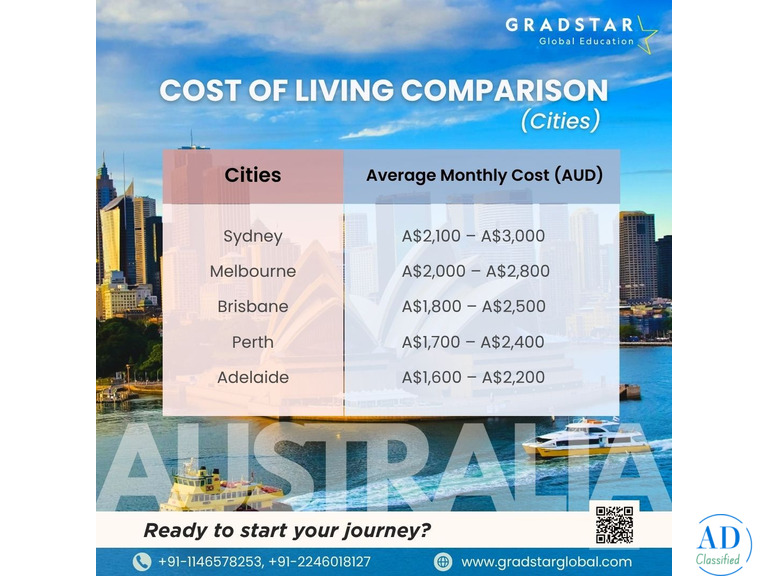Food, Travel, Rent: The Big Three Living Costs in Australia
Free
Published date: 2025/10/14
- Location: New Delhi, New Delhi, Delhi, India
Name: Gradstar Global Education
Phone: 0773887xxxx
When planning to study in Australia, understanding the major components of living expenses is essential for effective budgeting. While tuition fees are often the most visible cost, food, travel, and rent — the “big three” living expenses — typically make up the largest portion of a student’s monthly budget. Proper planning around these three areas can help students live comfortably and make the most of their time abroad.
1. Rent and Accommodation
Accommodation is often the largest single expense for students. Options include:
On-campus housing: Convenient and community-oriented, costing AUD 250–450 per week, often including utilities and internet.
Shared apartments or houses: Popular among students for cost savings, ranging from AUD 150–300 per week, depending on city and location.
Private rentals: Offer privacy and independence, costing AUD 350–600 per week in major cities.
Homestays: Include meals and utilities, typically AUD 250–350 per week, providing a supportive environment for international students.
City choice greatly affects rent: Sydney and Melbourne are the most expensive, while Adelaide, Brisbane, and Hobart offer more affordable options.
2. Food and Groceries
Food expenses vary depending on lifestyle and whether students cook at home or dine out. On average, students spend AUD 80–200 per week on groceries. Cooking at home, buying local produce, and using student discounts can significantly reduce costs. Dining out occasionally is part of the social experience, but budgeting for it helps avoid overspending.
3. Travel and Transportation
Transportation costs depend on the city, distance from campus, and chosen mode of travel. Students typically spend AUD 20–60 per week on public transport, with many cities offering discounted student passes. Walking or cycling is often feasible in smaller cities and regional areas, providing a cost-effective and healthy alternative.
Budgeting Tips for the Big Three
Rent: Consider shared housing or living slightly outside city centers to save money.
Food: Plan meals, buy in bulk, and shop at local markets.
Travel: Use student concession cards, choose walking or cycling where possible, and plan trips efficiently.
By carefully managing rent, food, and transport costs, students can optimize their budget while still enjoying a high-quality lifestyle in Australia. Focusing on these three areas allows for better financial control, reduces stress, and ensures that students can dedicate more energy to their studies and social experiences.
Read /blog/cost-of-living-comparison-students-in-australia- /
1. Rent and Accommodation
Accommodation is often the largest single expense for students. Options include:
On-campus housing: Convenient and community-oriented, costing AUD 250–450 per week, often including utilities and internet.
Shared apartments or houses: Popular among students for cost savings, ranging from AUD 150–300 per week, depending on city and location.
Private rentals: Offer privacy and independence, costing AUD 350–600 per week in major cities.
Homestays: Include meals and utilities, typically AUD 250–350 per week, providing a supportive environment for international students.
City choice greatly affects rent: Sydney and Melbourne are the most expensive, while Adelaide, Brisbane, and Hobart offer more affordable options.
2. Food and Groceries
Food expenses vary depending on lifestyle and whether students cook at home or dine out. On average, students spend AUD 80–200 per week on groceries. Cooking at home, buying local produce, and using student discounts can significantly reduce costs. Dining out occasionally is part of the social experience, but budgeting for it helps avoid overspending.
3. Travel and Transportation
Transportation costs depend on the city, distance from campus, and chosen mode of travel. Students typically spend AUD 20–60 per week on public transport, with many cities offering discounted student passes. Walking or cycling is often feasible in smaller cities and regional areas, providing a cost-effective and healthy alternative.
Budgeting Tips for the Big Three
Rent: Consider shared housing or living slightly outside city centers to save money.
Food: Plan meals, buy in bulk, and shop at local markets.
Travel: Use student concession cards, choose walking or cycling where possible, and plan trips efficiently.
By carefully managing rent, food, and transport costs, students can optimize their budget while still enjoying a high-quality lifestyle in Australia. Focusing on these three areas allows for better financial control, reduces stress, and ensures that students can dedicate more energy to their studies and social experiences.
Read /blog/cost-of-living-comparison-students-in-australia- /



